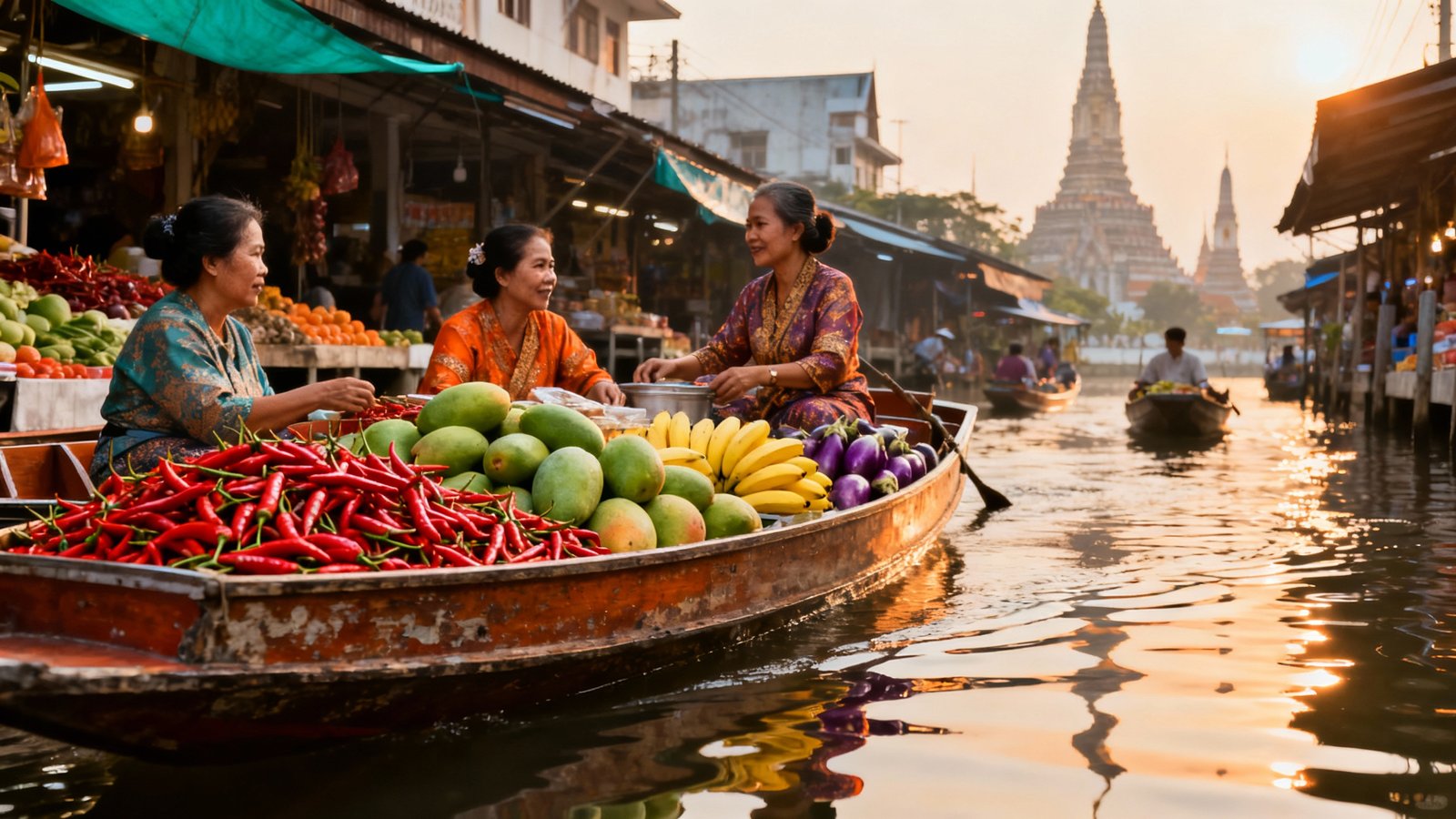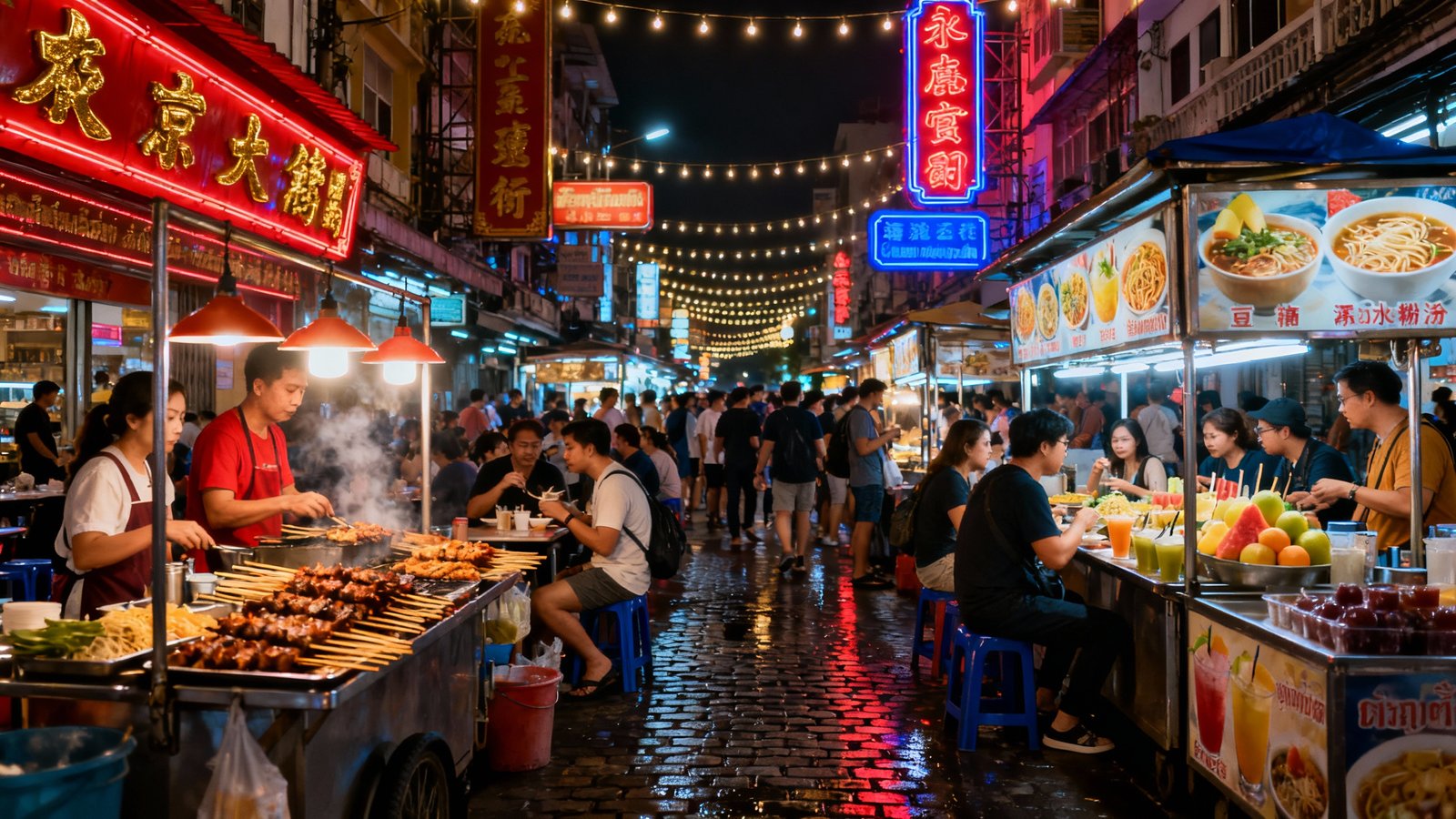Key Takeaways
- Discover Bangkok’s diverse street-food scene and why it’s revered worldwide.
- Find out which classic Thai dishes are absolute must-tries for every visitor.
- Explore where to taste the most authentic pad thai, tom yum, and som tam.
- Navigate the best floating and night markets for fun foodie adventures.
- Learn about Bangkok’s most famous street vendors and hidden culinary gems.
- Gain tips on food hygiene, ordering, and local dining etiquette.
- Get recommendations for hotels, tours, and rooftop dining destinations, with helpful resources for smart travel planning.
 Introduction
Introduction
Bangkok is a city where every corner hums with the rhythm of sizzling woks and the aroma of spice-laced air. Here, food isn’t just sustenance—it’s a celebration of life, a form of everyday art, and a powerful bridge between past and present. As the Thai sun sets and neon lights flicker to life, the streets transform into an open-air banquet where old ladies deftly toss noodles in a flaming wok and young vendors serve secret family curries from pushcarts. Welcome to the world of Bangkok street food—a culinary playground that promises more than just flavor, but a genuine slice of local culture and warm hospitality. Dive in as we take you on a gastronomic journey through the must-eat dishes, buzzing street-food stalls, floating markets, and can’t-miss dining experiences that make Bangkok a legend among global food lovers.
Bangkok’s Food Culture
Why is Bangkok celebrated as a street-food paradise? The answer lies at the crossroads of tradition and invention. Generations of Thai families have perfected recipes and adapted them to the urban sprawl of Bangkok, where food is both affordable and inventive. Whether it’s a humble sidewalk vendor or a time-honored family shop, Bangkok’s food scene seamlessly blends centuries-old techniques with international flavors, thanks to influences from China, Malaysia, and the West. Beyond the flavors, it’s the feverish energy—scooters buzzing past, cooks shouting friendly greetings, and diners sharing tables—that makes the experience truly immersive. In Bangkok, every meal is a story waiting to be told.
Iconic Dishes You Must Try
No Bangkok food guide is complete without recommendations for the city’s legendary dishes. Pad thai, sweet-sour som tam (green papaya salad), and fiery tom yum soup are only the beginning. Head to iconic spots like Thip Samai for what many call the best pad thai in town, or seek out som tam at Chatuchak Market, where vendors crush chilies and green papaya to order. Comfortable with spice? Tom yum—brimming with lemongrass, shrimp, and wild herbs—can be found sizzling in tiny pots at roadside eateries. For an insider’s look at the city’s culinary landmarks, check out this comprehensive Bangkok food guide on Tripadvisor.
Pad Thai & Stir-Fried Favorites
Undoubtedly, pad thai is Bangkok’s ambassador to the world. But beyond its tamarind tang and peanut crunch lies a whole spectrum of wok-tossed delights waiting to be discovered. Seek out vendors along Phad Thai Road or in the backstreets of Sukhumvit, where chefs whip up fragrant pad see ew (stir-fried noodles with soy sauce) or spicy drunken noodles loaded with Thai basil. For purists and culinary adventurers alike, exploring smaller neighborhood joints in Bang Rak or Silom provides some of the most memorable stir-fry experiences. To join a local-led food crawl through Bangkok’s stir-fry hotspots, browse these guided food tours.
Bangkok’s Street-Food Legends
Every food lover who visits Bangkok should pay homage to its iconic street-food institutions. Leading the pack is Jay Fai—Bangkok’s legendary, Michelin-starred street chef. Her crab omelettes and drunken noodles draw crowds from around the world, weaving fiery flavor with decades of tradition. Also worth a special trip: Raan Jay Fai, a local favorite famous for wok-seared seafood and spicy curries, where lines snake around the block for a taste of culinary royalty. Curious about Jay Fai’s meteoric rise and signature dishes? Read more about her on Raan Jay Fai’s official profile.
Floating Markets
Bangkok’s floating markets transport visitors to another era, when waterways served as the lifeblood of trade and culture. The bustling Damnoen Saduak Floating Market remains a classic, where vendors paddle wooden boats piled high with steaming noodles, fresh-cut mango, and coconut pancakes. Amphawa, meanwhile, comes alive in the late afternoon, renowned for its grilled river prawns and smoky barbecue wafting over the canal. Drifting through these markets, you’ll savor not just food, but the sights and sounds of riverside Thai life. For tips on planning your visit and details on what to eat, discover more with this floating markets Tripadvisor page.

Chinatown (Yaowarat)
Yaowarat, Bangkok’s legendary Chinatown, is a nocturnal world of dazzling neon, sizzling woks, and serpentine queues for the city’s best eats. Seafood reigns supreme at sidewalk stalls, with grilled prawns and fried crab a local obsession, while dessert carts tempt with sesame balls and sweet Thai pancakes. The best way to explore? Follow your nose (and the local crowds) after sundown, when the buzz is palpable and the air crackles with anticipation. If you’re intrigued by Yaowarat’s kaleidoscopic flavors, explore further through this curated Chinatown food walking tour.

Night Markets & Local Bazaars
After dark, Bangkok’s night markets awaken with a riot of flavors, colors, and quirky finds. The Ratchada Train Market is famed not only for its Instagrammable train-car stalls, but for stands dishing up lava cheese toast, Korean-style fried chicken, and all manner of Thai snacks. For a more localized vibe, wander through Talad Neon, beloved for its diverse food trucks and late-night sweet treats. The energy here is contagious—dining becomes as much about the atmosphere as the plate. Looking for directions and details? This Night Markets Guide provides essential tips.
Modern Thai Restaurants
Bangkok’s new generation of chefs is redefining Thai cuisine, blending age-old recipes with international techniques. At places like Bo.lan or Nahm, tradition takes on a modern twist with organic ingredients and artful plating. These restaurants promise not just a meal but a uniquely personal interpretation of Thai flavors. Reservations are often essential, and menus change seasonally—a testament to the city’s creative spirit. For a taste of acclaimed modern Thai dining, see the Michelin Guide’s Bangkok recommendations.
Traditional Desserts
To sweeten your food adventures, Bangkok offers a seductive array of classic desserts. Mango sticky rice is a beloved staple, its creamy coconut sauce and fragrant sticky rice pairing perfectly with luscious local mango. Vendors slice and serve mangoes at their juiciest during the hot season. Other must-tries include coconut ice cream (often served in a coconut shell with toasted peanuts) and khanom buang—crispy Thai crepes filled with meringue and sweet or savory toppings. These treats are found everywhere from markets to pushcarts, perfect as an afternoon refresher or late-night treat.

Coffee & Tea Culture
Coffee culture in Bangkok is now as energetic as its street-food scene. Independent cafés serve everything from locally sourced drip coffee to Thai iced tea (cha-yen), instantly recognizable by its bold orange hue and sweet, creamy flavor. Hip districts like Ari, Sathorn, and Thonglor brim with creative baristas and cozy hideouts—perfect for unwinding between meals or fueling up for another culinary adventure. Check out popular local cafés on Bangkok’s café scene guide.
Vegetarian & Vegan Eats
Plant-based travelers will find themselves spoiled for choice in Bangkok. Many classic Thai dishes—like massaman curry, tofu pad thai, and spicy vegetable salads—can be enjoyed in meatless versions. Additionally, numerous Buddhist temples prepare vegan meals (jay cuisine), especially during the annual Vegetarian Festival. From dedicated vegan bistros in Sukhumvit to adaptable street vendors, eating green has never been easier. Find top-rated veggie-friendly places with this Bangkok vegetarian dining guide.
Cooking Classes & Food Tours
For hands-on travelers, Bangkok’s cooking classes offer an unforgettable experience. Learn how to fold spring rolls, balance the flavors of tom yum, or craft your own curry paste under the guidance of expert locals. Food tours, meanwhile, are a shortcut to the city’s hidden gems, letting you eat like a true Bangkokian—from morning markets to late-night soup stalls. Many tours are conducted by passionate foodies eager to reveal their favorite haunts. Interested in authentic culinary classes and group tastings? Explore curated options on the best Bangkok food tours.
Where to Stay for Food Lovers
Choosing the right neighborhood sets the stage for your food explorations. Chinatown positions you amidst legendary night stalls; Sukhumvit offers international cuisine and easy transport; and Riverside hotels blend tranquility with bustling market access. Check out handpicked hotels within steps of these culinary hubs and unlock exclusive rates at this Bangkok hotel booking site.
Best Rooftop Dining Views
There’s nothing quite like savoring Thai cuisine while gazing out over the city skyline. Rooftop restaurants and bars like Sirocco, Vertigo & Moon Bar, and Octave pair creative menus with breathtaking panoramas. Whether you’re after a sunset cocktail or a full-course meal under the stars, these venues promise an experience every bit as unforgettable as the views.

Day Trips for Food Lovers
Food adventures in Bangkok can expand beyond the city limits. Just north, Ayutthaya offers towering temple ruins paired with riverside feasts of giant river prawns. Amphawa’s canals, meanwhile, beckon with their evening floating market and mouthwatering seafood. These excursions combine history, scenery, and flavors in one easy outing. For travel details and reviews, check out this Ayutthaya food and history tour.
Practical Tips for Eating in Bangkok
Bangkok is a food lover’s dream, but a little know-how goes a long way. Eat where the locals eat, as lines are a good sign of freshness and quality. Always opt for freshly cooked dishes, use provided utensils (instead of hands), and keep hand sanitizer handy. Learn a few basic Thai phrases—like “mai phet” (not spicy) if you need to ask for less heat! If you’re exchanging money to pay cash at markets, secure the best rates using this trusted currency exchange service.
Travel Insurance & Booking Essentials
Eating adventurously is part of the fun, but travel mishaps can happen. Comprehensive insurance covers everything from flight delays to unexpected tummy troubles—a smart safety net for any international trip. Before you travel, compare options with this reliable travel insurance portal.
Getting Around for Food Adventures
Bangkok’s extensive BTS Skytrain network makes hopping between foodie destinations a breeze. For markets off the main routes, tuk-tuks and river ferries offer local color (and a bit of adventure!). If you prefer self-guided exploration or trips into the countryside, consider booking a rental car through a trusted car rental provider.
Conclusion
To eat in Bangkok is to experience the city’s heart and soul—one bowl of noodles, one spoonful of curry, or one perfect mango at a time. The city’s culinary tapestry is as sprawling and vibrant as its skyline, from humble pushcarts to elegant sky-high restaurants. Whether you’re a first-timer or a seasoned visitor, Bangkok ensures every meal is an adventure, every street a discovery, and every flavor a postcard from Thailand’s rich history. For food lovers, it’s not just a destination—but a delicious journey you’ll want to revisit, again and again. If you’re ready to plan your next culinary adventure, TripVista360’s smart booking page makes crafting your dream trip as easy as ordering your favorite Thai dish.
FAQs
What are the must-try dishes in Bangkok?
Pad thai, tom yum soup, som tam (green papaya salad), satay skewers, mango sticky rice, and Thai green curry are essential for any first-time visitor.
Where can I find authentic street food in Bangkok?
Yaowarat (Chinatown), Victory Monument, and Ratchada Train Market are classic hotspots, but you’ll find great vendors throughout residential neighborhoods and local markets.
Are Bangkok’s street foods safe to eat?
Generally yes, especially from busy stalls with fast turnover. Choose freshly cooked items and follow local recommendations for quality.
Is vegetarian or vegan food easy to find?
Absolutely—many Thai dishes are or can be made meat-free. Look for “jay” restaurants or stalls marked with a yellow and red sign, especially during the Vegetarian Festival.
What’s the best way to pay at food stalls and markets?
Cash is king, but more places now accept e-wallets. ATMs are widely available; exchange rates are best through reputable services.
When is the best time to visit for food lovers?
Cool season (November to February) is most comfortable; however, every season brings unique fruits, specialties, and festivals.
How can I book food tours or cooking classes?
There are many online platforms specializing in local culinary tours—be sure to check verified user reviews and seek out experiences led by local chefs or passionate foodies.



 Introduction
Introduction





